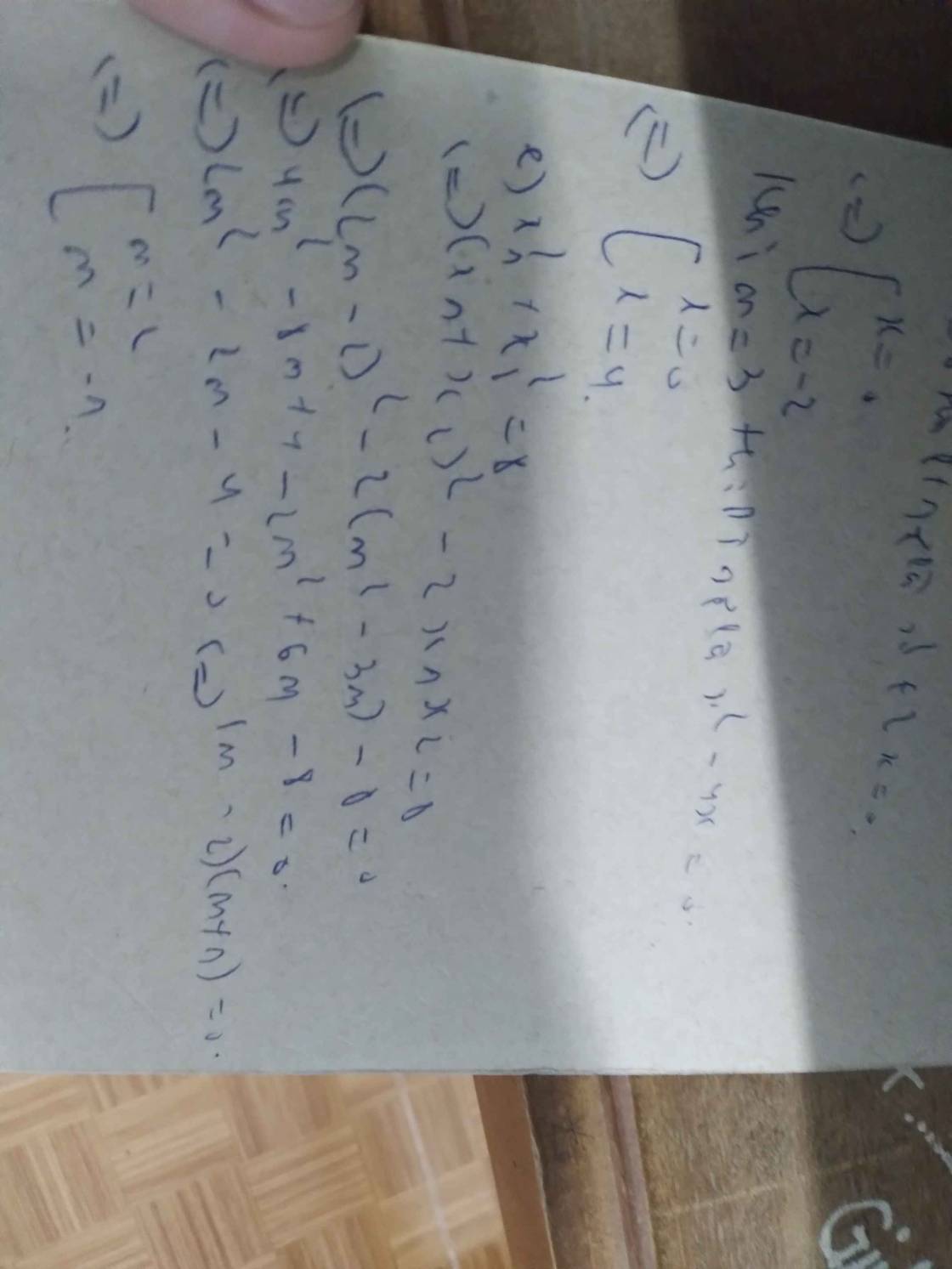Hãy nhập câu hỏi của bạn vào đây, nếu là tài khoản VIP, bạn sẽ được ưu tiên trả lời.

1.Ta có \(\Delta=4m^2-4\left(m^2-m-3\right)=4m+12\)
Để phương trình có 2 nghiệm phân biệt \(\Rightarrow\Delta>0\Rightarrow4m+12>0\Rightarrow m>-3\)
Theo hệ thức Viet ta có \(\hept{\begin{cases}x_1+x_2=2m\\x_1.x_2=m^2-m-3\end{cases}}\)
a. Phương trình có 2 nghiệm trái dấu \(\Rightarrow x_1.x_2< 0\Rightarrow m^2-m-3< 0\Rightarrow\frac{1-\sqrt{13}}{2}< m< \frac{1+\sqrt{13}}{2}\)
Vậy \(\frac{1-\sqrt{13}}{2}< m< \frac{1+\sqrt{13}}{2}\)
b. Phương trình có 2 nghiệm phân biệt dương \(\Leftrightarrow\hept{\begin{cases}x_1+x_2=2m>0\\x_1.x_2=m^2-m-3>0\end{cases}\Leftrightarrow\hept{\begin{cases}m>0\\m< \frac{1-\sqrt{13}}{2}\end{cases}\left(l\right);\hept{\begin{cases}m>0\\m>\frac{1+\sqrt{13}}{2}\end{cases}\Leftrightarrow m>\frac{1+\sqrt{13}}{2}}}}\)
Vậy \(m>\frac{1+\sqrt{13}}{2}\)
2. a.Ta có \(\Delta=\left(2m-1\right)^2+4m=4m^2-4m+1+4m=4m^2+1\)
Ta thấy \(\Delta=4m^2+1>0\forall m\)
Vậy phương trình luôn có 2 nghiejm phân biệt với mọi m
b. Theo hệ thức Viet ta có \(\hept{\begin{cases}x_1+x_2=1-2m\\x_1.x_2=-m\end{cases}}\)
Để \(x_1-x_2=1\Leftrightarrow\left(x_1-x_2\right)^2=1\Leftrightarrow\left(x_1+x2\right)^2-4x_1x_2=1\)
\(\Leftrightarrow\left(1-2m\right)^2-4.\left(-m\right)=1\Leftrightarrow4m^2-4m+1+4m=1\)
\(\Leftrightarrow m^2=0\Leftrightarrow m=0\)
Vậy \(m=0\)thoă mãn yêu cầu bài toán

x^2-3x-(m-1)=0(1)
a)Dể phương trình có 2 nghiệm dương phân biệt:delta>0,S>0,P>0
9+4m-4>0>>>m>-5/4;S=3>0;P=m-1>0>>m>1.
>>>>Để(1) có 2 nghiệm phân biệt thì m>1.
b)x1^3+x2^3=18>>>(x1+x2)(x1^2-x1x2+x2^2)=18>>>x1^2-x1x2+x2^2=6
>>>(x1+x2)^2-3x1x2=6>>>3x1x2=3>>>x1x2=1
-(m-1)=1>>>m=0.
Vậy m=0

Bài 1:
a, Thay m=-1 vào (1) ta có:
\(x^2-2\left(-1+1\right)x+\left(-1\right)^2+7=0\\
\Leftrightarrow x^2+1+7=0\\
\Leftrightarrow x^2+8=0\left(vô.lí\right)\)
Thay m=3 vào (1) ta có:
\(x^2-2\left(3+1\right)x+3^2+7=0\\ \Leftrightarrow x^2-2.4x+9+7=0\\ \Leftrightarrow x^2-8x+16=0\\ \Leftrightarrow\left(x-4\right)^2=0\\ \Leftrightarrow x-4=0\\ \Leftrightarrow x=4\)
b, Thay x=4 vào (1) ta có:
\(4^2-2\left(m+1\right).4+m^2+7=0\\ \Leftrightarrow16-8\left(m+1\right)+m^2+7=0\\ \Leftrightarrow m^2+23-8m-8=0\\ \Leftrightarrow m^2-8m+15=0\\ \Leftrightarrow\left(m^2-3m\right)-\left(5m-15\right)=0\\ \Leftrightarrow m\left(m-3\right)-5\left(m-3\right)=0\\ \Leftrightarrow\left(m-3\right)\left(m-5\right)=0\\ \Leftrightarrow\left[{}\begin{matrix}m=3\\m=5\end{matrix}\right.\)
c, \(\Delta'=\left[-\left(m+1\right)\right]^2-\left(m^2+7\right)=m^2+2m+1-m^2-7=2m-6\)
Để pt có 2 nghiệm thì \(\Delta'\ge0\Leftrightarrow2m-6\ge0\Leftrightarrow m\ge3\)
Theo Vi-ét:\(\left\{{}\begin{matrix}x_1+x_2=2m+2\\x_1x_2=m^2+7\end{matrix}\right.\)
\(x_1^2+x_2^2=0\\ \Leftrightarrow\left(x_1+x_2\right)^2-2x_1x_2=0\\ \Leftrightarrow\left(2m+2\right)^2-2\left(m^2+7\right)=0\\ \Leftrightarrow4m^2+8m+4-2m^2-14=0\\ \Leftrightarrow2m^2+8m-10=0\\ \Leftrightarrow\left[{}\begin{matrix}m=1\left(ktm\right)\\m=-5\left(ktm\right)\end{matrix}\right.\)
\(x_1-x_2=0\\ \Leftrightarrow\left(x_1-x_2\right)^2=0\\ \Leftrightarrow\left(x_1+x_2\right)^2-4x_1x_2=0\\ \Leftrightarrow\left(2m+2\right)^2-4\left(m^2+7\right)=0\\ \Leftrightarrow4m^2+8m+4-4m^2-28=0\\ \Leftrightarrow8m=28=0\\ \Leftrightarrow m=\dfrac{7}{2}\left(tm\right)\)
Bài 2:
a,Thay m=-2 vào (1) ta có:
\(x^2-2x-\left(-2\right)^2-4=0\\ \Leftrightarrow x^2-2x-4-4=0\\ \Leftrightarrow x^2-2x-8=0\\ \Leftrightarrow\left[{}\begin{matrix}x=4\\x=-2\end{matrix}\right.\)
b, \(\Delta'=\left(-m\right)^2-\left(-m^2-4\right)\ge0=m^2+m^2+4=2m^2+4>0\)
Suy ra pt luôn có 2 nghiệm phân biệt
Theo Vi-ét:\(\left\{{}\begin{matrix}x_1+x_2=2\\x_1x_2=-m^2-4\end{matrix}\right.\)
\(x_1^2+x_2^2=20\\ \Leftrightarrow\left(x_1+x_2\right)^2-2x_1x_2=20\\ \Leftrightarrow2^2-2\left(-m^2-4\right)=20\\ \Leftrightarrow4+2m^2+8-20=0\\ \Leftrightarrow2m^2-8=0\\ \Leftrightarrow m=\pm2\)
\(x_1^3+x_2^3=56\\ \Leftrightarrow\left(x_1+x_2\right)^3-3x_1x_2\left(x_1+x_2\right)=56\\ \Leftrightarrow2^3-3\left(-m^2-4\right).2=56\\ \Leftrightarrow8-6\left(-m^2-4\right)-56\\ =0\\ \Leftrightarrow8+6m^2+24-56=0\\ \Leftrightarrow6m^2-24=0\\ \Leftrightarrow m=\pm2\)
\(x_1-x_2=10\\ \Leftrightarrow\left(x_1-x_2\right)^2=100\\ \Leftrightarrow\left(x_1+x_2\right)^2-4x_1x_2-100=0\\ \Leftrightarrow2^2-4\left(-m^2-4\right)-100=0\\ \Leftrightarrow4+4m^2+16-100=0\\ \Leftrightarrow4m^2-80=0\\ \Leftrightarrow m=\pm2\sqrt{5}\)

PT có nghiệm `<=> \Delta' >=0`
`<=> (m-1)^2-(m^2+2)>=0`
`<=>-2m-1>=0`
`<=>m <= -1/2`
Viet: `x_1+x_2=2m-2`
`x_1x_2=m^2+2`
`x_1^2+x_2^2=10`
`<=>(x_1+x_2)^2-2x_1x_2=10`
`<=>(2m-2)^2-2(m^2+2)=10`
`<=> 2m^2-8m=10`
`<=>` \(\left[{}\begin{matrix}m=-1\left(TM\right)\\m=5\left(L\right)\end{matrix}\right.\)
Vậy `m=-1`.

Vì phương trình có 2 nghiệm x1;x2
=> Theo vi-ét ta có
x1 + x2 = 2(m+1) và x1x2 = 2m+3
theo bài ra ta có
(x1 - x2)2 = 4
<=> x12 - 2x1x2 + x22 = 4
<=> x12 + 2x1x2 + x22 - 4x1x2 = 4
<=> (x1 + x2)2 - 4x1x2 = 4
<=> 4(m+1)2 - 4(2m+3) = 4
<=> (m+1)2 - (2m+3) = 1
<=> m2 + 2m +1 -2m -3 -1 = 0
<=> m2 - 3 = 0
<=> m2 = 3
<=> m\(=\pm\sqrt{3}\)
Vậy với m\(=\pm\sqrt{3}\) thì phương trình có hai nghiệm x1;x2 thỏa mãn (x1 - x2)2 = 4



Bài 5:
Để pt có 2 nghiệm $x_1,x_2$ thì:
$\Delta'=(m-1)^2-m^2\geq 0$
$\Leftrightarrow (m-1-m)(m-1+m)\geq 0$
$\Leftrightarrow 1-2m\geq 0\Leftrightarrow m\leq \frac{1}{2}(*)$
Áp dụng định lý Viet: \(\left\{\begin{matrix} x_1+x_2=2(m-1)\\ x_1x_2=m^2\end{matrix}\right.\)
Khi đó:
$(x_1-x_2)^2+6m=x_1-2x_2$
$\Leftrightarrow (x_1+x_2)^2-4x_1x_2+6m=(x_1+x_2)-3x_2$
$\Leftrightarrow 4(m-1)^2-4m^2+6m=2(m-1)-3x_2$
$\Leftrightarrow 4m-6=3x_2$
$\Leftrightarrow x_2=\frac{4}{3}m-2$
$x_1=2(m-1)-x_2=\frac{2}{3}m$
Suy ra:
$x_1x_2=m^2$
$\Leftrightarrow \frac{2}{3}m(\frac{4}{3}m-2)=m^2$
$\Leftrightarrow m(8m-12-9m)=0$
$\Leftrightarrow m(-m-12)=0$
$\Leftrightarrow m=0$ hoặc $m=-12$. Theo $(*)$ ta thấy 2 giá trị này đều thỏa mãn.
Bài 4:
Để pt có 2 nghiệm thì $\Delta'=4-2(2m^2-1)\geq 0$
$\Leftrightarrow m^2-1\leq 0\Leftrightarrow -1\leq m\leq 1$
Áp dụng định lý Viet: \(\left\{\begin{matrix} x_1+x_2=2\\ x_1x_2=\frac{2m^2-1}{2}\end{matrix}\right.\)
Khi đó:
$2x_1^2+4mx_2+2m^2-1\geq 0$
$\Leftrightarrow (2x_1^2-4mx_1+2m^2-1)+4mx_1+4mx_2\geq 0$
$\Leftrightarrow 0+4m(x_1+x_2)\geq 0$
$\Leftrightarrow 4m. 2\geq 0$
$\Leftrightarrow m\geq 0$
Kết hợp với điều kiện $-1\leq m\leq 1$ suy ra $0\leq m\leq 1$ thì ycđb được thỏa mãn.